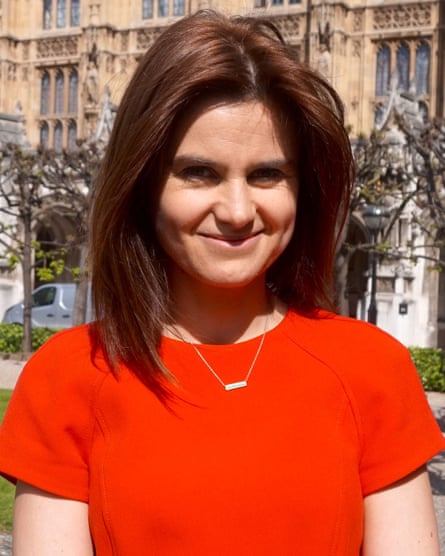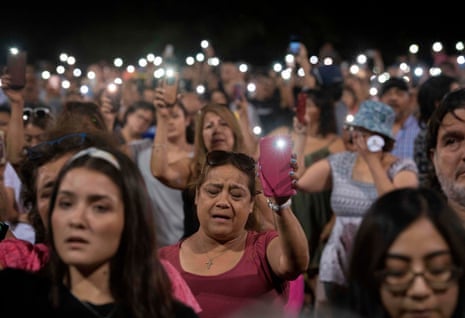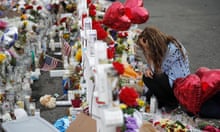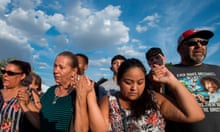Reports that the suspected gunman at a Walmart in El Paso, Texas, saw his mass shooting as “a response to the Hispanic invasion of Texas” has prompted bipartisan calls for the US to treat the threat of domestic “white terrorists” as seriously as the threat of attacks by supporters of al-Qaida or Isis.
But experts who study racist violence say the attack must be understood not just as a domestic problem within the United States, but as part of a global network of white nationalist radicalization and violence.
The escalating global death toll from white nationalist attacks puts a spotlight on the social media companies that have allowed white nationalists to organize on their platforms with little interference, as well as on the clear parallels between white terrorists’ justification for their attacks, and the racist and anti-immigrant rhetoric of some mainstream politicians. Donald Trump has repeatedly referred to immigrants and refugees as an “invasion”.
A global problem
A “manifesto” that appeared to be linked to the El Paso attack on Saturday described the growing number of Latinx people in Texas as an “invasion” that threatened the political power of white residents. The shooting, which left at least 22 people dead, is being investigated by federal officials as an act of domestic terrorism.
Perpetrators of other recent attacks around the world indicated that they, too, believed that white people were under attack, and that immigrants, refugees and other people of color are “invaders” who put the white race at risk.

The Canadian man who opened fire at a mosque in Quebec in January 2017. The American man who plowed his car into a crowd of protesters after a white supremacist rally in Charlottesville, Virginia, later that year. The 46-year-old American who allegedly attacked a Pittsburgh synagogue in 2018. The Australian man who allegedly killed 51 people at two mosques in Christchurch, New Zealand, this March.
Many of these attacks inspired even more acts of violence. The suspected Christchurch shooter, who is accused of livestreaming his murder of dozens of innocent people in New Zealand in March, appears to have inspired at least two additional mass shootings in the United States within five months. In April, another young white man opened fire at a synagogue in Poway, California, killing one woman and injuring three other people. He cited the Christchurch attacks as his model, prosecutors said. On Saturday, the manifesto linked to the El Paso shooting, too, referred to the Christchurch massacre as an explicit inspiration.
“Too many people still think of these attacks as single events, rather than interconnected actions,” the historian Kathleen Belew, author of Bring the War Home: The White Power Movement and Paramilitary America, wrote in an opinion column on Sunday. “We spend too much ink dividing them into anti-immigrant, racist, anti-Muslim or antisemitic attacks. True, they are these things. But they are also connected with one another through a broader white power ideology.”
Defining white nationalism
At the center of contemporary white nationalist ideology is the belief that whiteness is under attack, and that a wide range of enemies – from feminists to leftwing politicians to Muslims, Jews, immigrants, refugees and black people – are all conspiring to undermine and destroy the white race, through means as varied as interracial marriage, immigration, “cultural Marxism” and criticism of straight white men.
TimelineA history of recent attacks linked to white nationalism
Show
In the past decade, across continents, white supremacists have repeatedly chosen the same targets for shootings, stabbings, bombings and car attacks.
77 killed in a bomb attack, followed by a shooting targeting the island summer youth camp of Norway’s Labor party. The shooter wanted to prevent an 'invasion of Muslims' and deliberately targeted politically active young people who he saw as 'cultural Marxists'. More than half of the dead were teenagers.
Six worshippers including the temple president are killed. The shooter, a ''frustrated neo-Nazi' who had played in white power bands, was a regular on racist websites. He had previously talked to one colleague in the US military about a 'racial holy war that was coming'.
Rapper and anti-fascist activist Pavlos Fyssas was stabbed to death. A senior member of Greece’s neo-Nazi Golden Dawn party was imprisoned after confessing to the killing.
A former Ku Klux Klan leader shot and killed three people at a Jewish centre and retirement home, one of them just 14 years old. He said he believed Jews were destroying the white race, and that diversity was a kind of genocide.
Nine people killed during Bible study at a historic black church. The victims included elderly longtime church members at the Mother Emanuel AME church, and Clementa Pinckney, a state senator. The shooter, a self-avowed white supremacist, said he wanted to start a race war.
An attacker stabbed students and teachers at a high school, targeting those with darker skin, police said. Three died, including 15-year-old Ahmed Hassan, who was born in Somalia and had recently moved to Sweden.
Labour MP Jo Cox shot and stabbed to death a week before the EU referendum vote in 2016. The man convicted of killing her, a white supremacist obsessed with the Nazis and apartheid-era South Africa, shouted: 'This is for Britain,' 'Keep Britain independent' and 'Britain first' as he killed her.
Six people killed and nineteen injured during evening prayers at a mosque in a shooting which the gunman said was prompted by Justin Trudeau’s tweet that refugees were welcome in Canada, and that 'diversity is strength'.
Timothy Caughman stalked and killed by a white supremacist with a sword. His killer, an American military veteran, said he targeted a random black man on the street in New York City as a 'practice run' for a bigger attack, and as part of a campaign to persuade white women not to enter into interracial relationships.
Two men were killed and one injured after they tried to intervene to protect young women on a public train who were being targeted with an anti-Muslim tirade. Their alleged killer shouted 'Free speech or die' in the courtroom, and 'Death to Antifa!'
One killed and 12 people injured after a van ploughed into worshippers outside a mosque. The killer shouted 'I want to kill all Muslims – I did my bit' after the van attack. A judge concluded he had avidly consumed anti-Muslim propaganda from prominent rightwing figures.
Heather Heyer killed and dozens injured after a car ploughed into anti-Nazi protesters. The killer had been obsessed with Hitler as a teenager, according to a former teacher.
Man attempted to enter black church before allegedly killing two black people in a supermarket. A witness said that during the attack, the alleged shooter said: 'Whites don’t kill whites.'
11 killed in a mass shooting targeting the Tree of Life synagogue. The alleged shooter had an active profile on an extremist social media site, where he accused Jewish people of trying to bring 'evil' Muslims into the US, and wrote that a refugee aid organisation 'likes to bring invaders in that kill our people'.
51 people were killed and 49 injured in two consecutive attacks on mosques during Friday prayers. The gunman live-streamed the first attack on Facebook Live. They opened the live stream by urging viewers to 'subscribe to PewDiePie', a meme used by the online alt-right and white supremacists.
One person killed in mass shooting targeting a synagogue in Poway, California, US. The alleged shooter, 19, from California, opened fire in a synagogue during Passover services, killing a 60-year-old woman and injuring three others. An“open letter” posted on the 8chan extremist message board before the attack included white nationalist conspiracy rhetoric and said the shooter was inspired by the New Zealand mosque attacks.
21 people killed after a shooter opened fire at a busy Walmart store packed with families shopping. Two dozen more were injured. The 21-year-old white male suspect had driven nine hours to reach his target. and had posted a "manifesto" on 8chan.
Lois Beckett and Martin Belam
To people who believe in white supremacist conspiracies, demographic change is an “existential threat to white people”, said Cynthia Miller-Idriss, a professor of education and sociology at the American University, and a senior fellow at the Centre for Analysis of the Radical Right.
These conspiracy theories refer to demographic shifts in dramatic, violent terms, as a kind of “genocide” or a “great replacement” of one people with another. The idea of “replacement” is central to this movement: “You will not replace us! Jews will not replace us!” white nationalists and neo-Nazis chanted as they marched with flaming torches through Charlottesville, Virginia. It has echoed in the manifestos of mass murderers, and the chants of Charlottesville marchers, since being coined by a French white nationalist writer and conspiracy theorist in 2011.

But in many of the countries where white nationalist radicalization is a threat – including the United States, Canada, Australia and New Zealand – white people are, in fact, not the native population, and are not being displaced.
Despite this, recent racist violence in the United States, Canada, New Zealand and Europe, is linked by the shared conspiracy that “white people are being displaced from their home countries”, said Heidi Beirich, the intelligence director at the Southern Poverty Law Center (SPLC), an organization that monitors American hate groups.
“At the extreme end of white supremacy you have this group of people who believe that the only way to create change is to create a violent societal collapse, that will lead to apocalyptic end times, and a race war, and then eventually to restoration and rebirth,” Miller-Idriss said.
Attacks closely linked to mainstream politics
Though antisemitism is at the heart of white nationalist conspiracy theories, many different groups are labeled as enemies. In the past decade, deadly attacks linked to white nationalism have been carried out against Muslims, Jews, African Americans at Bible study in a historic black church, leftwing activists and politicians in the United States and across Europe. More than 175 people have been killed in at least 16 high-profile attacks linked to white nationalism around the world since 2011.
And although politicians often label white nationalist violence as “senseless”, analysts suggest that hate crimes often spike alongside political events like elections. Many of these “senseless” attacks have been carried out during key moments of mainstream political debates over immigration and refugee policy.
Jo Cox, a British member of parliament, was assassinated by a far-right extremist in June 2016, in the run-up to the Brexit referendum. Pro-Brexit campaigners claimed at the time that voting to remain in the European Union would would result in “swarms” of immigrants entering the UK, and that it would prompt mass sexual attacks. Cox’s killer shouted “Britain first!” as he shot and stabbed her to death.

The shooting at the Tree of Life synagogue in Pittsburgh – the worst antisemitic mass murder in US history – happened during the run up to the midterm elections. At that time, conservative media and Republican politicians were promoting fears of a “caravan” of migrants heading towards the country from Central America. Congressman Matt Gaetz was one of those who suggested that the caravan had been orchestrated by the Jewish financier George Soros.
Trump, who spent years questioning the citizenship of America’s first black president, has continuously made public comments that include white nationalist rhetoric. He campaigned on a ban on Muslim immigration, a border wall, and in his campaign announcement suggested that Mexican migrants were rapists. As president, he has characterized migrants as invaders in several tweets. At a rally in May, Trump used the term “invasion” to describe the arrival of immigrants at the southern border. At the same rally he raised the prospect of using weapons on immigrants. When Trump asked “How do you stop these people?” someone in the crowd shouted, “Shoot them!” and Trump laughed.
“When you have politicians using language like invasion and infestation, it reinforces extremist beliefs in a way that makes them more legitimate,” Miller-Idriss said.
Who mainstreams white nationalist ideas?
Conservative and even mainstream media outlets have also played a role in mainstreaming white nationalist ideas. Beirich, of the SPLC, said that the concept of demographic replacement is “definitely cropping up in conservative media”, pointing to the Fox News anchors Tucker Carlson and Laura Ingraham as having broadcast programs which “may not use the same language” but which convey the same basic narrative of “replacement”.
Although white nationalism is far from a new ideology, today’s racist activists have been adept at using social networks to expand their reach and radicalize a new generation of young white men and women. They have worked under a veil of irony and trolling explicitly designed to create uncertainty in the mainstream public about how serious they are. That effort has been extremely successful.
Facebook and Instagram only banned content advocating white nationalism, like “The US should be a white-only nation,” four months ago. Previously, the company suggested in a post announcing the ban, it had considered white nationalism or white separatism valid political viewpoints, and had believed in the arguments, rejected by experts, that “white nationalism” was not necessarily racist.
“There is so much material on the web – treatises, tracts, and manifestos – that would have been extraordinarily difficult to get hold of 25 years ago,” said Brian Levin, the director for the Center for the Study of Hate and Extremism.

Whatever internet platforms do now to crack down on violent white nationalist content, racist activists from across the world have been able to connect and organize online for more than a decade, with little interference, said Joan Donovan, the director and lead researcher of the Technology and Social Change Research Project at the Shorenstein Center on Media, Politics and Public Policy at Harvard Kennedy School.
That has given them time to share strategies and organize across international borders. “That kind of time, put into this movement, is really dangerous,” Donovan said.
By the numbers
While there are no official surveys of hate crimes in the United States, several organizations that monitor them across disparate jurisdictions and reporting standards say that crimes motivated by white supremacy have been rising in recent years.
According to a report last week from the Center for the Study of Hate and Extremism (CSHE) at CSU San Bernardino, there were 17 homicides carried out by white nationalists in the US alone in 2018. This constituted the vast majority of the 22 extremist murders that CSHE counted that year.
Earlier in the year, the Anti-Defamation League (ADL) reported that all but one of 50 extremist-linked murders they counted were committed by people with direct links to white supremacist movements or ideologies. The exception was a killing by an Islamic extremist who had previously been involved with white supremacy.
Since 9/11, the United States has devoted $2.8tn to counterterrorism, according to the Stimson Center, with almost $500bn going to the Department of Homeland Security in that time period. But the small slice of this devoted to rightwing extremists has been further diminished in the Trump era. Earlier this year DHS disbanded a group of intelligence analysts focused on domestic terror threats, after shutting down programs specifically directed at neo-Nazis and other far right groups.
According to the Brookings Institution’s Eric Rosand, when it comes to domestic terrorism, “the United States continues to rely almost entirely on the police”.
At the local level, law enforcement officials across the country have faced scrutiny for failing to take seriously the threat of white nationalist violence, and for sometimes devoting more attention to policing anti-fascist protesters than violent neo-Nazis. Some American law enforcement officials have said they were unprepared to deal with white nationalist violence.
Beirich says that “the FBI has admitted that this is the number one domestic terror threat, but then at the same time federal agencies have been focused on Islamic extremism for so long they are way behind the eight ball on this”.









